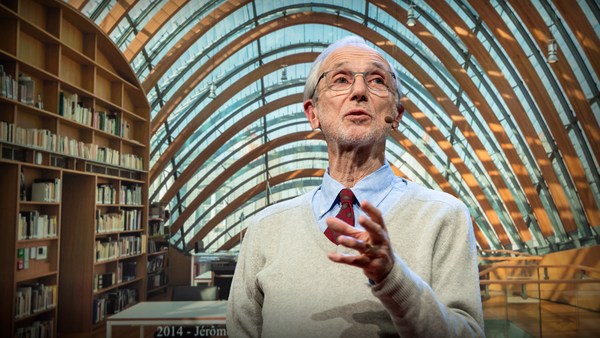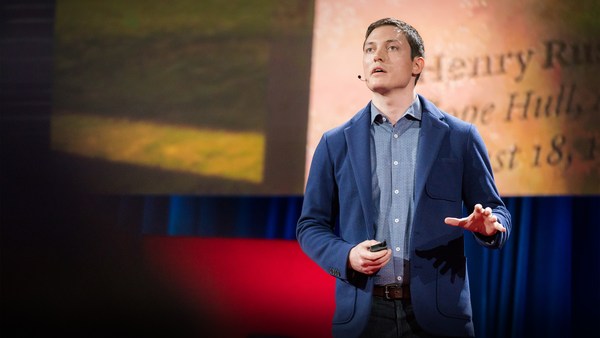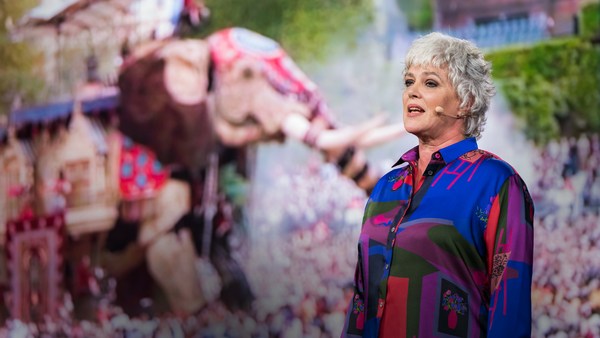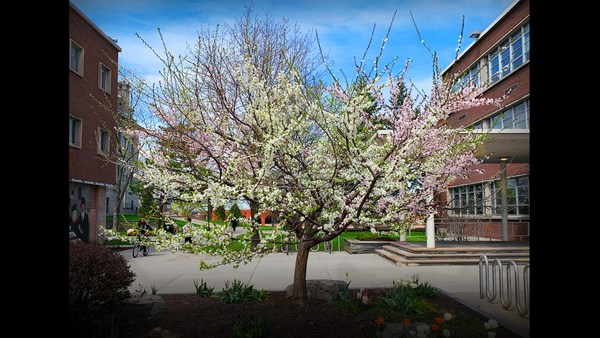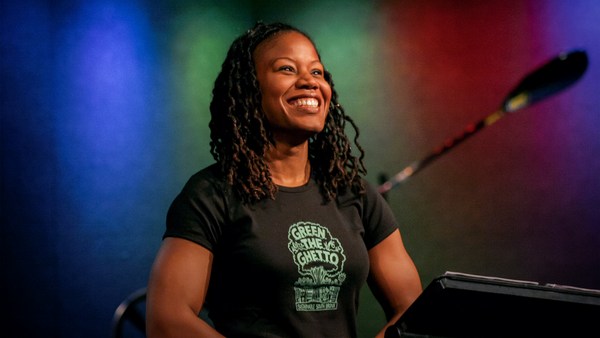How can landscapes imbue memory? When we think about this notion "e pluribus unum" -- "out of many, one," it's a pretty strange concept, right? I mean, with all different races and cultures of people, how do you boil it down to one thing? I want to share with you today this idea of "e pluribus unum" and how our landscape might imbue those memories of diverse perspectives, as well as force us to stop trying to narrow things down to a single, clean set of identities.
As an educator, designer, I'd like to share with you five simple concepts that I've developed through my work. And I'd like to share with you five projects where we can begin to see how the memory around us, where things have happened, can actually force us to look at one another in a different way. And lastly: this is not just an American motto anymore. I think e pluribus unum is global. We're in this thing together.
First, great things happen when we exist in each other's world -- like today, right? The world of community gardens -- most of you have probably seen a community garden. They're all about subsistence and food. Right? I'll tell you a little story, what happened in New York more than a decade ago. They tried to sell all of their community gardens, and Bette Midler developed a nonprofit, the New York Restoration Project. They literally brought all the gardens and decided to save them. And then they had another novel idea: let's bring in world-class designers and let them go out into communities and make these beautiful gardens, and maybe they might not just be about food. And so they called me, and I designed one in Jamaica, Queens. And on the way to designing this garden, I went to the New York Restoration Project Office, and I noticed a familiar name on the door downstairs. I go upstairs, and I said, "Do you guys know who is downstairs?" And they said, "Gunit." And I said, "Gunit? You mean G-Unit? Curtis '50 Cent' Jackson?"
(Laughter)
And they said, "Yeah?" And I said, "Yes."
And so we went downstairs, and before you knew it, Curtis, Bette and the rest of them formed this collaboration, and they built this garden in Jamaica, Queens. And it turned out Curtis, 50 Cent, grew up in Jamaica. And so again, when you start bringing these worlds together -- me, Curtis, Bette -- you get something more incredible. You get a garden that last year was voted one of the top 10 secret gardens in New York. Right?
(Applause)
It's for young and old, but more importantly, it's a place -- there was a story in the Times about six months ago where this young woman found solace in going to the garden. It had nothing to do with me. It had more to do with 50, I'm sure, but it has inspired people to think about gardens and sharing each other's worlds in a different way.
This next concept, "two-ness" -- it's not as simple as I thought it would be to explain, but as I left to go to college, my father looked at me, and said, "Junior, you're going to have to be both black and white when you go out there." And if you go back to the early parts of the 20th century, W.E.B. Du Bois, the famous activist, said it's this peculiar sensation that the Negro has to walk around being viewed through the lens of other people, and this two-ness, this double consciousness. And I want to argue that more than a hundred years later, that two-ness has made us strong and resilient, and I would say for brown people, women -- all of us who have had to navigate the world through the eyes of others -- we should now share that strength to the rest of those who have had the privilege to be singular.
I'd like to share with you a project, because I do think this two-ness can find itself in the world around us. And it's beginning to happen where we're beginning to share these stories. At the University of Virginia, the academical village by Thomas Jefferson, it's a place that we're beginning to notice now was built by African hands. So we have to begin to say, "OK, how do we talk about that?" As the University was expanding to the south, they found a site that was the house of Kitty Foster, free African American woman. And she was there, and her descendants, they all lived there, and she cleaned for the boys of UVA. But as they found the archaeology, they asked me if I would do a commemorative piece. So the two-ness of this landscape, both black and white ... I decided to do a piece based on shadows and light. And through that, we were able to develop a shadow-catcher that would talk about this two-ness in a different way. So when the light came down, there would be this ride to heaven. When there's no light, it's silent. And in the landscape of Thomas Jefferson, it's a strange thing. It's not made of brick. It's a strange thing, and it allows these two things to be unresolved.
And we don't have to resolve these things. I want to live in a world where the resolution -- there's an ambiguity between things, because that ambiguity allows us to have a conversation. When things are clear and defined, we forget.
The next example? Empathy. And I've heard that a couple of times in this conference, this notion of caring. Twenty-five years ago, when I was a young pup, very optimistic, we wanted to design a park in downtown Oakland, California for the homeless people. And we said, homeless people can be in the same space as people who wear suits. And everyone was like, "That's never going to work. People are not going to eat lunch with the homeless people."
We built the park. It cost 1.1 million dollars. We wanted a bathroom. We wanted horseshoes, barbecue pits, smokers, picnic tables, shelter and all of that. We had the design, we went to the then-mayor and said, "Mr. Mayor, it's only going to cost you 1.1 million dollars." And he looked at me. "For homeless people?" And he didn't give us the money.
So we walked out, unfettered, and we raised the money. Clorox gave us money. The National Park Service built the bathroom. So we were able to go ahead because we had empathy.
Now, 25 years later, we have an even larger homeless problem in the Bay Area. But the park is still there, and the people are still there. So for me, that's a success. And when people see that, hopefully, they'll have empathy for the people under freeways and tents, and why can't our public spaces house them and force us to be empathetic? The image on the left is Lafayette Square Park today. The image on the right is 1906, Golden Gate Park after the earthquake. Why do we have to have cataclysmic events to be empathetic? Our fellow men are out there starving, women sleeping on the street, and we don't see them. Put them in those spaces, and they'll be visible.
(Applause)
And to show you that there are still people out there with empathy, the Oakland Raiders' Bruce Irvin fries fish every Friday afternoon for anyone who wants it. And by going to that park, that park became the vehicle for him.
The traditional belongs to all of us, and this is a simple one. You go into some neighborhoods -- beautiful architecture, beautiful parks -- but if people look a different way, it's not traditional. It's not until they leave and then new people come in where the traditional gets valued.
A little quick story here: 1888 opera house, the oldest in San Francisco, sits in Bayview–Hunters Point. Over its history, it's provided theater, places for businesses, places for community gatherings, etc. It's also a place where Ruth Williams taught many black actors. Think: Danny Glover -- came from this place. But over time, with our 1980s federal practices, a lot of these community institutions fell into disrepair. With the San Francisco Arts Council, we were able to raise money and to actually refurbish the place. And we were able to have a community meeting. And within the community meeting, people got up and said, "This place feels like a plantation. Why are we locked in? Why can't we learn theater?" Over the years, people had started putting in chicken coops, hay bales, community gardens and all of these things, and they could not see that traditional thing behind them. But we said, we're bringing the community back. American Disability Act -- we were able to get five million dollars. And now, the tradition belongs to these brown and black people, and they use it. And they learn theater, after-school programs. There's no more chickens. But there is art.
And lastly, I want to share with you a project that we're currently working on, and I think it will force us all to remember in a really different way. There are lots of things in the landscape around us, and most of the time we don't know what's below the ground. Here in Charleston, South Carolina, a verdant piece of grass. Most people just pass by it daily. But underneath it, it's where they discovered Gadsden’s Wharf. We think more than 40 percent of the African diaspora landed here. How could you forget that? How could you forget? So we dug, dug, and we found the wharf. And so in 2020, Harry Cobb and myself and others are building the International African American Museum. And it will celebrate --
(Applause)
this place where we know, beneath the ground, thousands died, perished, the food chain of the bay changed. Sharks came closer to the bay. It's where slaves were stored. Imagine this hallowed ground.
So in this new design, the ground will erupt, and it will talk about this tension that sits below. The columns and the ground is made of tabby shales scooped up from the Atlantic, a reminder of that awful crossing. And as you make your way through on the other side, you are forced to walk through the remains of the warehouse, where slaves were stored on hot, sultry days, for days, and perished. And you'll have to come face-to-face with the Negro, who worked in the marshes, who was able to, with the sickle-cell trait, able to stand in high waters for long, long days. And at night, it'll be open 24/7, for everybody to experience.
But we'll also talk about those other beautiful things that my African ancestors brought with them: a love of landscape, a respect for the spirits that live in trees and rocks and water, the ethnobotanical aspects, the plants that we use for medicinal purposes. But more importantly, we want to remind people in Charleston, South Carolina, of the black bodies, because when you go to Charleston today, the Confederacy is celebrated, probably more than any other city, and you don't have a sense of blackness at all.
The Brookes map, which was an image that helped abolitionists see and be merciful for that condition of the crossing, is something that we want to repeat. And I was taken by the conceptuality of this kind of digital print that sits in a museum in Charleston. So we decided to bring the water up on top of the surface, seven feet above tide, and then cast the figures full length, six feet, multiply them across the surface, in tabby, and then allow people to walk across that divide. And hopefully, as people come, the water will drain out, fill up, drain out and fill up. And you'll be forced to come to terms with that memory of place, that memory of that crossing, that at times seems very lucid and clear, but at other times, forces us again to reconcile the scale. And hopefully, as people move through this landscape every day, unreconciled, they'll remember, and hopefully when we remember, e pluribus unum.
Thank you.
(Applause)
